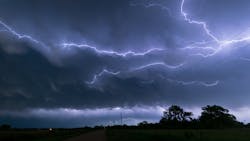Transmission Makes the Grid Resilient to Extreme Weather
Each additional gigawatt (GW) of transmission capacity connecting the Texas power grid (ERCOT) with neighboring states in the Southeast could have saved nearly US$1 billion and kept the heat on for approximately 200,000 Texas homes during Winter Storm Uri in February of 2021, according to a new report released by the American Council on Renewable Energy (ACORE). The report, 'Transmission Makes the Power System Resilient to Extreme Weather', details the value additional transmission would have provided during five severe weather events in Texas, the Northeast and the Midwest between 2014 and 2021.
The report found that additional transmission ties would have generated significant cost savings for consumers and reduced outages during recent extreme weather events by canceling out local fluctuations in the supply and demand of electricity and providing alternative sources of power in an emergency.
“As severe weather events become more frequent, our balkanized power grid is increasingly unable to deliver reliable electricity to consumers who need it,” said ACORE president and CEO Gregory Wetstone. “This report demonstrates that we are already paying an enormous price for our lack of interregional transmission, and that the benefits of a robust transmission grid would quickly surpass the cost of constructing new lines. It is time to implement pro-transmission policies to enable the investments we need to strengthen our grid, lower costs for consumers and reduce power outages during extreme weather events.”
Severe weather key findings include:
- February 2021 Winter Storm Uri — Each additional GW of transmission ties between ERCOT and the Southeastern U.S. could have saved nearly US$1 billion, while keeping the heat on for hundreds of thousands of Texans. Other parts of the Central U.S. also could have avoided power outages while saving consumers over US$100 millions
- The “polar vortex” event in the Midwest in 2019 — An additional 1GW of transmission between MISO and PJM would have saved around US$2.4 million, evenly split between the regions
- The January 2014 “polar vortex” event in the Northeast — Greater transmission ties among New England, New York, and the Mid-Atlantic region could have saved consumers tens of millions of dollars and prevented reliability concerns.
- The “Bomb Cyclone” cold snap across the Northeast in December 2017-January 2018 — Each additional GW of interregional transmission ties could have saved New England, New York, and the Mid-Atlantic regions US$30-40 million each.
- Texas heat wave in August 2019 — Each additional GW of transmission ties between ERCOT and the Southeastern U.S. could have saved consumers nearly US$75 million.
Lessons Learned
“Weather can cause large fluctuations in electricity demand and supply, as all energy sources can be disrupted by severe weather,” explained report author Michael Goggin, vice-president at consulting firm Grid Strategies LLC. “Extreme weather typically only affects a limited area, so expanding the power grid is one of the best ways to protect consumers and national security. Interregional transmission not only provides a lifeline for regions experiencing severe weather, but also enables reliable and cost-effective decarbonization of the power grid by canceling out local fluctuations in solar and wind output. Making the grid bigger than the weather provides massive reliability, economic, and environmental benefits.”“The report reaffirms that transmission is critical to ensure reliable, low-cost energy for customers, and it is consistent with MISO’s analysis of the February Artic Event which concluded that new transmission capacity, along with improved interregional coordination and interconnection, will bring significant benefits to facilitate reliability and efficiency,” said Jennifer Curran, vice-president of system planning at the Midcontinent Independent System Operator.
“As this report demonstrates, interregional transmission is integral to keeping the lights on and power costs low during extreme weather events,” said Adrienne Mouton-Henderson, deputy director of policy innovation, Renewable Energy Buyers Alliance (REBA). “A reliable, resilient grid is essential to all customers and REBA supports scaling interregional transmission that unlocks access to low-cost renewable energy resources while saving customers money.”
The report also outlines the pro-transmission policies that would help realize these benefits, including provisions to reform planning, paying for and permitting new lines. Transmission Makes the Power System Resilient to Extreme Weather was commissioned by ACORE and authored by Grid Strategies LLC. To download the report, click here. To watch the webinar release detailing the report findings, click here.
The Macro Grid Initiative, a joint effort of the American Council on Renewable Energy and Americans for a Clean Energy Grid, seeks to expand and upgrade the nation’s transmission network to deliver job growth and economic development, a cleaner environment, and lower costs for consumers.
About the Author
Alex Hobson
Alex Hobson is ACORE's vice president of communications. Her responsibilities include overseeing the organization's internal and external communications, media relations, digital and social media efforts, and brand management. Prior to joining ACORE, Hobson was the director of external communications for the Solar Energy Industries Association (SEIA), where she served as a spokesperson for the solar industry, managing SEIA's earned media, video production, and various communications campaigns. Before moving to the nation's capital, Hobson was an award-winning broadcast journalist, working in several TV markets throughout the state of Florida. She graduated with highest honors from the University of Florida.
